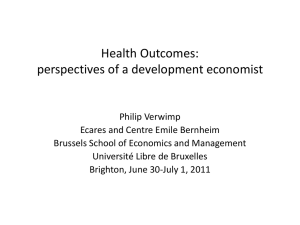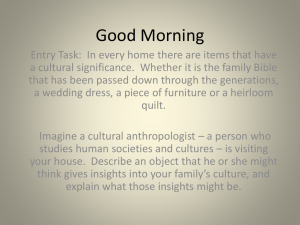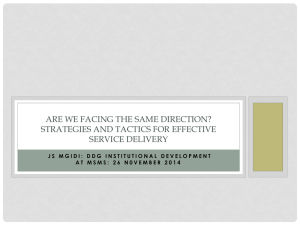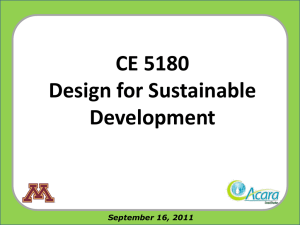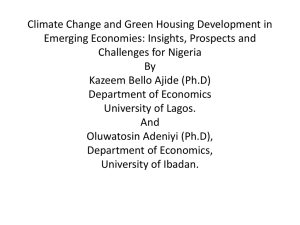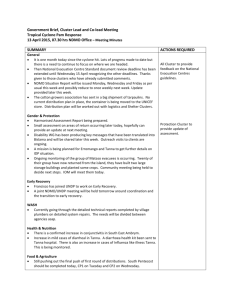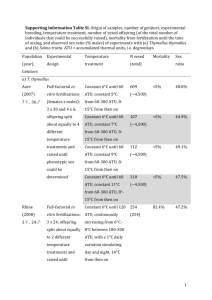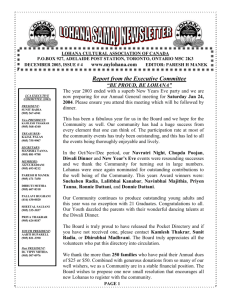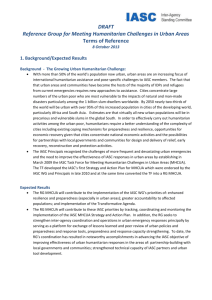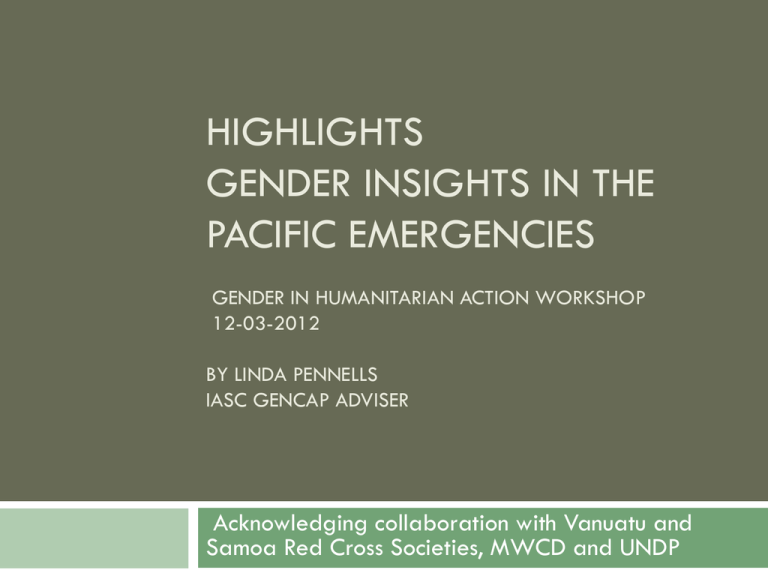
HIGHLIGHTS
GENDER INSIGHTS IN THE
PACIFIC EMERGENCIES
GENDER IN HUMANITARIAN ACTION WORKSHOP
12-03-2012
BY LINDA PENNELLS
IASC GENCAP ADVISER
Acknowledging collaboration with Vanuatu and
Samoa Red Cross Societies, MWCD and UNDP
Session Flow
Gender insights into TC Vania in Vanuatu - 2010
Participants’ insights on the Fiji floods– 2012
Gender reflection on the Tuvalu Drought -2011
Gender insights from the Samoa Tsunami -2009
Introducing gender tools for humanitarian action
Gender Insights into TC Vania/Atu
Two TCs hit Tafea Province, S Vanuatu, in early 2011
TC Vania (Jan 12-13) and TC Atu (Feb 20-22)
Prolonged wind and rain from TC Vania (Cat 1)
damage staple and cash crops
TC Atu (Cat 4) deepens crop loss
TCs piggybacked drought and volcanic acid rain in
Tanna, Tafea’s largest island
Women’s participation
Few women in: NDMO, TAGs, area councils, many
community disaster committees, some NGOs
Without women: DRM has only half the energy,
skills, solutions
Women’s participation is essential as a ‘critical
mass’ in:
Assessments
All
DRM mechanisms from NDMO down to community
Community disaster committees
WASH
Cluster approach attracts donors to step forward (TOR,
timely assessment, response plan, strategic use of
members’ capacities)
NFIs distributed then water systems repaired in 5
months (50+ systems)
Lost opportunity – no engagement of women/men to
revitalize water user groups – no hygiene, sanitation or
O&M - could have built onto RWS and NGO
training/facilitation
Shortage of women in WASH distribution teams (one
only per team)
WASH cont’d
Gender analysis warranted: collapsible jerry cans,
purification tabs vs filters
Good gender practice:
Gender-balanced
team demonstrate water testing in
Tanna communities
Cluster post-completion questionnaire shows women as
well as men influenced design in some communities
VRCS field teams identify/correct Aniwa beneficiary
lists: 45 uncounted HHs, mainly widow and singlemother HHs
Agriculture and Food
Response revolves around distribution of rice, fastgrowing seeds and cuttings.
600+ bags of rice were rain damaged. Others
walked.
Stakeholder and community consultations suggest
that, “women would not let rice get wet and spoil”
and their involvement would better insure inclusive
equitable and accountable distribution
Agriculture – good practice
Power of ‘kava mail’ –
nakamal network facilitates
exchange of Middlebush
taro for W Tanna coconut
Distribution of seeds and
cuttings familiar to Tafea
men & women
Livelihoods assessment
of Futuna and Aniwa
called for balanced
support to pandanus
handicrafts (women’s
income) and fisheries
industries (men’s income).
Chiefs close markets
Consultation: Tafeo Coop Market (21 women vendors)
Reason for closure: “If they see you selling, there will
be no rice”
Result:
Lost income
Rotting food
Customers forced to buy less-nutritious costly shop
food
*Sale of kava and Whitesands fish was not interrupted
Protection
Risks to children, especially girls, were identified in
the Vania Joint Damage Assessment but no formal
protection response followed.
Violence and neglect data: Tanna Women’s
Counseling Centre
New domestic violence clients: up more than 300%
2010 (12 months) – 12 2011 (9 months) - 39
More cases of men not paying child maintenance
2010 (12 months) – 14
2011 (9 months) - 39
Protection
UNICEF pocket-sized brochure used in WASH
distribution included psycho-social messages.
One psycho-social stress cited, particularly for
women, is failure to meet church donation targets.
Health and Nutrition
Action
Needed
Lenakel Hospital: Due to unrepaired
damage of reproductive health unit,
post-Vania drop in pre-natal and postnatal consultations, increase in
unplanned pregnancies, increase in
hospital admissions from bush abortions
gone wrong.
Health and Nutrition cont’d
Priority not invested in collecting health lessons learned.
MoH/WHO do not collect sex-disaggregated data for
disaster response (child or adult) or document variances
between women and men.
Nutrition: Three weeks after cyclone strike was
identified as the ‘hunger peak’. Nutrition needs were
not fully assessed for timely response (e.g. micro-nutrients, Vit
A, iodized salt, breastfeeding). Long-term potential of cluster
assessment: evidence to identify an appropriate ‘food
basket’ and pre-positioning arrangements.
SC discussing research into boy preference and its
potential manifestation in emergencies (food, school)
Education
MoE took responsibility for
repairing schools and
waived secondary school
fees to prevent student
pull-out.
EMIS reports total Tafea
secondary enrollment in the
term following the cyclones
as 1139 boys and 1137
girls. This is 47 more boys
and 143 more girls than in
the corresponding term in
2010.
The telling evidence will
be in student attendance
– figures not yet
available.
Questions and Comments
Plenary discussion:
Vania response
On to the Fiji floods –
pairs discussion
Gender Insights – Tuvalu Drought
No attempt to focus on the most vulnerable: i.e.
water and NFIs for all - no extra water for pregnant
and lactating women
Women’s Division excluded from drought decisionmaking body
Outer island assessment (5 islands) team includes 1
woman and 13 men
No gender analysis of root causes of drought and
water management practices (i.e. poor guttering
care, leaking tanks, wasteful water use)
Gender Insights – Samoa Tsunami
Most deaths: children, women and the elderly – assess
capacities and vulnerabilities of women, girls, boys, men
Preparedness
Better vulnerability mapping by community men and
women: people living on the fringe of villages (FHHs,
freeholders, ostracized families, squatters) e.g. Ma Nuu Manuia
Project
Clear distribution criteria and process- full
participation of women and men
More gender analysis, sex and age disaggregated
data and gender indicators in DRR and recovery (Progress
Report: Hyogo and DRM -2011)
Better land dispute mechanisms for all, especially
women
Gender Insights continued
Micro credit interest relief is in place
Coordinated mental health mechanism for psychosocial response and skills upgrading in trauma
counseling for equal # of men & women
Response
Ensure equity in shelter and water sharing e.g. community
cohesion suffers when some extended families get one fale and others get
fales for each of their constituent nuclear families; community water tanks.
Experience shows engaging women can assist with both water and shelter
equity.
Early Recovery
Ensure equal benefit. Be pro-active in ensuring men and
women fully participate in planning & in livelihoods
Gender Insights – continued
More consideration is needed to a Protection Cluster
and protection issues: (gaps)
Weak capture of domestic violence / GBV
Care giver burn-out and unmet PS need
American wives advertise ‘come get an orphan’
Involve but do not over-rely on women’s
committees, pastors and their wives in times of
family trauma
Ensure a gender analysis: e.g. boys play dead/burying
games; Poutasi teacher reports boys and male teachers able to return to
school weeks earlier than girls and female teachers
Best Practices
Some good efforts to have a critical mass of women
and men in field teams (SRC 60%M-40%W)
Samoan diaspora (women and men) contributed to
high level of appropriateness in food and NFIs. Still
needed, however, is a list of appropriate food and
NFIs including drugs, ensuring infant formula does not
replace breast milk, food is not expired and items are
culturally appropriate.
Private sector initiative: tourist fale recovery – vital
employment for young men and women (fewer
alternatives for female youth)
Gender Resources
IASC Gender Marker Tip Sheets: gender analysis
questions and tips to help create gender-responsive
projects: http://gencap.oneresponse.info
Free gender e-training which features gender issues
in each humanitarian cluster. Certificate issued for
all who complete this interactive training: www.iascelearning.org or order a free CD ROM from
gender@iasc.elearning.org

